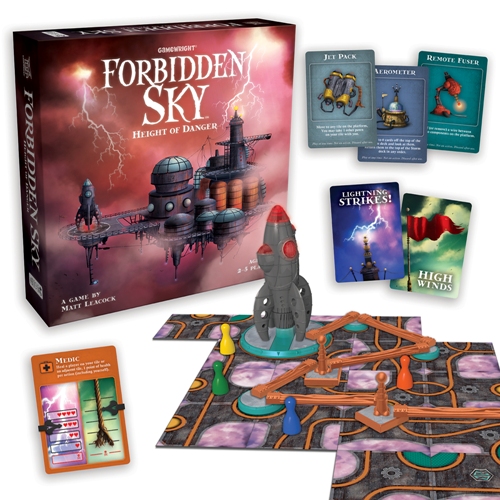Matt Leacock is trying to kill us all—and now he’s found new ways to do it.
Leacock has churned out a series of hit cooperative games, led by Pandemic and its spinoff Pandemic Legacy, that each offer players a different experience and difficulty level. Pandemic is the most involved and complex; Mole Rats in Space is the simplest, a version for kids that strips the game down to its most basic mechanics. In between are the “Forbidden” games, which already included Forbidden Desert and Forbidden Island, along with the newest Leacock title, Forbidden Sky, which sneaks a STEM element into the now familiar mechanics all of these games use. This time, players not only have to survive the game’s challenge, but must lay tiles to create a complete an electric circuit so they can power the game’s rocket ship (which lights up and makes noise) to escape.
Players in Forbidden Sky are working on a floating platform where they’re beset by high winds that threaten to blow them off the board. The rocket that would allow them to leave the platform (and win the game) must be powered by a circuit that players build as they place tiles, wiring it as they go—but when lightning strikes the board, any player who’s standing on a wired tile gets shocked. Once the circuit is complete, the rocket takes off (not literally), and if all players are standing somewhere on the four launch pad tiles at that moment, the players win.
By far the biggest difference between Forbidden Sky and its siblings in the series is that players have two separate ways to die (and lose). Each player has two meters on their card tracking their health, which is affected by lightning strikes that deliver shocks to players, and the strength of the ropes holding them on the platform, which is frayed every time high winds would blow the player off the edge of the board. There are ways to restore health to a player, and to strength a player’s ropes, but there aren’t a ton of them, and as the board expands and the circuit is wired, players can lose health faster than you can restore it.

Forbidden Sky is also the first game in the series where players build the board as they go. Each player can hold up to three tiles in their hand, and then gets to lay them on the board to lay out the platform as they want, while also trying to align certain tiles so that the essential components of the circuit, including the launch pad for the rocket, are formed. The difficulty of the game is a function of how big a circuit you choose to complete, with four options given in the base game. All circuits must include the launch pad and a minimum number of large transformers, small transformers, and lightning rods, and must be completely wired in a single loop. Components like transformers appear on the board as soon as their shapes are completed on the tiles, but players must use actions to wire them together—which also means that they can wait to wire things until they can safely leave the area to avoid getting electrocuted.
As in other games in the series, players take on different roles with specific abilities, like the ability to add wires without using actions or to transport other players around the board. Each player role also has a unique number of starting health points and rope strength, so if you select roles (instead of just dealing them out randomly), there are real pros and cons to consider with each type. The board itself has teleporters to allow players to jump around the board, and spaces that protect players on them from lightning or winds. There’s also a second deck of special items, similar to what you’d find in Forbidden Desert, that give players one-time boosts like restored health points or the ability to move on the board, which players acquire when they add a tile with the Item symbol on it.
Forbidden Sky is, in my experience at least, pretty damn challenging, especially with four players. Once the game is nearing its end, enough of the circuit is wired that getting player tokens to safe spaces on the board—not standing near a live wire, not standing near an edge so they might get blown off—is critical, but not simple; with four players, you’re going to take a couple of hits of juice or gusts of wind before your turn comes back around. Achieving all parts of the objective requires a fair amount of coordination among players and ability to envision how the board might grow, since you can’t move tiles you’ve placed, and must be able to think of how that circuit might look when it’s completed and what tiles you might still draw to allow you to place the required components. If you have experience with any of Leacock’s cooperative games, you know how the mechanics work—the turns of up to four actions, free uses of special cards, drawing from the Storm deck after each player’s turn, etc.—and the learning curve for Forbidden Sky will be pretty short. If you don’t, as much as I like Forbidden Sky as a game, it might be easier to learn this if you’ve played Forbidden Island or Desert (tabletop or app versions) first, before you electrocute yourself on this clever new twist.
Keith Law is a senior baseball writer for ESPN.com and an analyst on ESPN’s Baseball Tonight. You can read his baseball content at search.espn.go.com/keith-law and his personal blog the dish, covering games, literature, and more, at meadowparty.com/blog.

